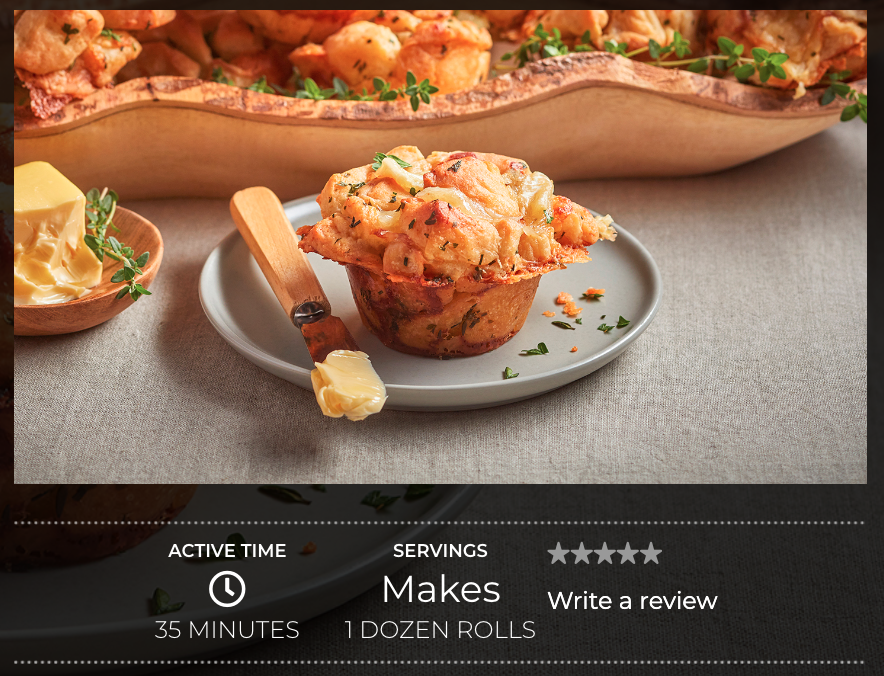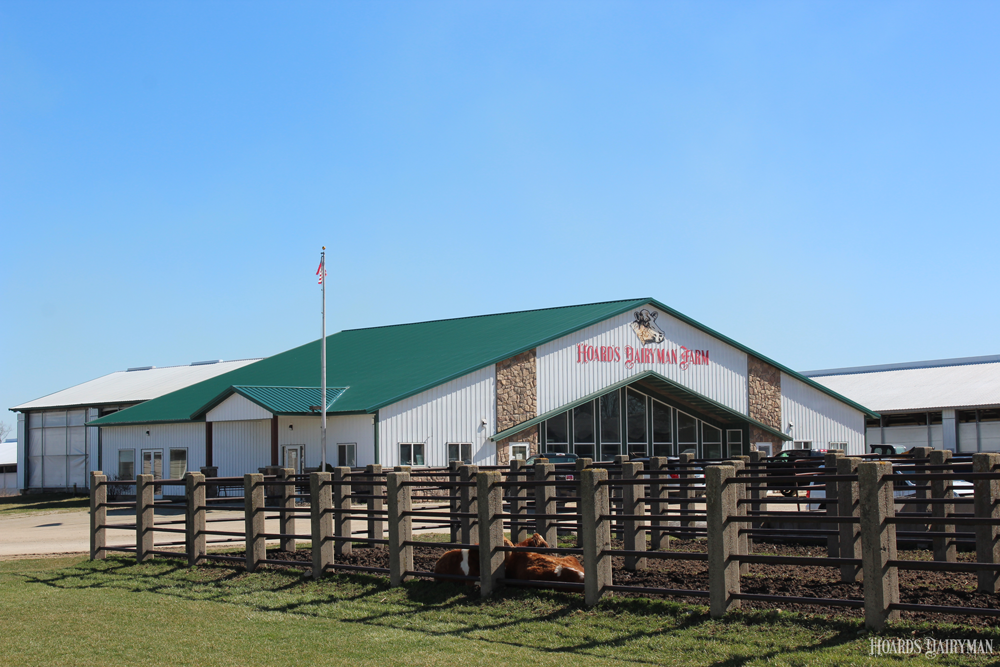New Recipe: Dinner Rolls with Camembert-Style Cheese
Dinner Rolls made with St. Saviour. This recipe is brought to you by Dairy Farmers of Wisconsin (DFW).
Ingredients: 18 frozen dough dinner rolls1 1/2 wheels (9 ounces) Hoard’s Dairyman Farm Creamery St. Saviour cheese6 tablespoons butter, cubed and melted3 tablespoons minced fresh parsley2 tablespoons snipped fresh chives2 teaspoons minced fresh thyme1 teaspoon garlic powder
InstructionsPlace frozen dinner rolls on a greased 17 x 12-inch baking pan; cover with plastic wrap. Thaw rolls for 1 1/2 hours at room temperature. Cut each roll into six equal pieces. Cover and let rise for 1 1/2 hours.Heat oven to 350°F.Cut St. Saviour into 1/2-inch pieces. Freeze for 15 minutes.Whisk the butter, parsley, chives, thyme and garlic powder in a large bowl. Toss dough in butter mixture.Arrange nine dough pieces and St. Saviour in twelve lightly greased muffin cups.Cover pan with aluminum foil. Bake for 12 minutes. Uncover; bake for 15-18 minutes longer or until golden brown. Let cool for 5 minutes in the pan. Gently run a knife around edges to loosen rolls. Remove from the pan. Garnish with parsley.
Cheesemonger TipSt. Saviour is a soft-ripened, camembert-style cheese with rich, buttery flavor and has a soft, creamy core inside a delectable rind. It’s best served on a charcuterie cheese board at room temperature.Meet Our New Creamery Director
Ricardo Gutierrez
What do you get when you mix a historic dairy farm and an experienced food engineer? Thankfully, we won’t have to wait long to find out. Ricardo Gutierrez joined W.D. Hoard and Sons Co. in 2023 as the Creamery Director and has wasted no time in applying his talents and expertise to our cheese production process. As a practiced cheesemaker who studied in Europe and Mexico before making Wisconsin his home, Ricardo came to us with an abounding background and a salient vision. He is not interested in complacency. He sees beyond what’s before him, what is, to what can be, and is thus equipped to lead Hoard’s Dairyman Farm Creamery cheese to the peak of its potential.“When I was in Mexico and with other companies, I was making cheese the whole week. I enjoy this position at Hoard’s Dairyman because it is cheesemaking, but it is also research and development, sales and shipment – lots of new things. It keeps me busy,” Gutierrez said.During our conversation, I couldn’t help but believe as sincerely as he did in the possibilities embedded within Hoard’s Dairyman as a company and as a leader in cheesemaking. His energy was palpable and infectious. “We’re looking to expand our reach and develop new recipes. We’re hoping to be able to export our cheese to Mexico, too,” he said.Gutierrez was quick to credit the Hoard’s Dairyman Farm Guernsey herd for the quality of our Creamery cheese. The herd’s milk is made up of about 4.8% to 5.2% fat, as opposed to the 3.8% to 4.0% fat of Holstein herds, on average. With quality milk — and quality leadership — comes quality cheese. Gutierrez has only been with Hoard’s Dairyman for the better part of a year, but his leadership transcends date-of-hire. He’s still mid-jump in a boundless surge forward, and he’s bringing all of us at Hoard’s and all of you, our faithful cheese-lovers, with him. Look for more about what Ricardo is bringing to the table in future Creamery Notes issues, and order your own variety of Hoard’s Dairyman Farm Creamery cheese at hoardscreamery.com. Down on the Farm: A Hoard's Dairyman Farm Spotlight
Just like W.D. Hoard himself, we believe that good soil and healthy cows means quality dairy products. That includes the Hoard’s Dairyman Farm Creamery cheese you put on your sandwich, the milk you froth for your coffee, and the yogurt you include in your smoothie. But what does conscientious dairy farming look like? What do milking, cow care, and calf raising actually entail?In an effort to provide our readers with a comprehensive background as to where our milk, cheese, magazine, and brand come from, the Hoard’s Dairy Farm Creamery would like to dedicate the next few issues of its Creamery Notes newsletter to showcasing the Hoard’s Dairyman Farm. Our hope is that, by including one such article in each newsletter, our readers will not only learn more about the dairy industry as a whole and thus adopt a deeper appreciation for their morning cereal and afternoon cappuccino, but, too, that it will lay the foundation for a steadfast honoring of the 139-years-old dairy farming trailblazer that is W.D. Hoard and Sons Co. Over the next few weeks, in the pages of this newsletter, we will share with you the ins and outs of the Hoard’s Dairyman Farm operations, starting next issue with a short biography of the man himself, the “Father of Modern American Dairying,” W.D. Hoard. To brush up on Hoard’s Dairyman content or to order Hoard’s Dairyman Farm Creamery cheese, visit hoards.com and hoardscreamery.com, respectively. This is why you should eat cheese: Cheese lovers, rejoice! Cheese is as nutritious as it is tasty. Read to learn why.
Do you know what makes a cheese platter even better? It’s the ability to indulge in that spread of Gouda, White Cheddar, and Butterkase guilt-free. Cheese contains nutrients such as calcium, magnesium, protein, and vitamins A and B12 that contribute to preventative health benefits. Further, consuming it regularly within serving-size guidelines has been proven to reduce the risk of cardiovascular disease and increase all-around whole-body health. According to a series of studies published by Advances in Nutrition, a peer-reviewed journal dedicated to scientific and nutritional research, the lowest risk of all-cause mortality among participants was observed at the consumption of approximately 40 grams of cheese per day. This optimal 35 to 40 grams per day held consistent throughout alternative focus groups as well, leveling out steadily (creating an “L” shaped curve) in studies pertaining to the “relative risk of incident” for cardiovascular disease, congenital heart disease, and stroke. This means people who consumed no cheese were at a slightly higher risk for acquiring these diseases than people who consumed 35 to 40 grams of cheese per day. To cheese lovers, this may not seem like much cheese. Forty grams is just a little over 1/3 cup. But it’s important to note that 40 grams is where the data began to level, not rise, meaning there is some wiggle room. Consuming more than this was not directly linked to an increase in relative risk for each of the diseases. Cheese has also been shown to improve cognitive function and bone health and contribute to hip fracture prevention. What’s more, it has the added benefit of pairing well with a variety of foods, making it a healthful alternative to highly processed snacks and meals. Fruits, nuts, bread, and wine are among the most popular pairings, and, should one want to encounter the smell and flavor of a specialty cheese at its finest, eating a chunk of cheese all on its own can be a singularly enjoyable (and nourishing) experience. View our selection of Hoard’s Dairyman Farm Creamery cheeses here.To the cheesery, and beyond! The cheesemaking process is long and involved. Read to learn how your favorite block or curd is made.
Picture this: you’re at a high school graduation party. You plop four — nay, five — tomato and mozzarella skewers onto your plate. You then sing their praises to the host, who points to a cherry tomato plant near the lawn’s edge. Aha! You’re ecstatic to know the source. But wait — where did the cheese come from? At the Hoard’s Dairyman Farm Creamery, we know exactly where our cheese comes from and how it’s made — and so can you.It all starts with high-quality milk from our own Hoard’s Dairyman Farm, and we pride ourselves on having some of the best in the nation. From there, it’s about the cheesemaking process: a tradition as old and practiced as milking itself. Cheese began as an inadvertent discovery (forgotten milk turned accidentally to curd) and is now a beloved food. But where does it come from, and how is it made? For instance, did you know that it takes ten pounds of milk to make one pound of cheese? Or that the scale of a cheese’s sweet or bitter taste depends on how much starter culture is added to the pre-curded milk? Or that coagulation is the process during which milk proteins thicken, and rennet refers to added enzymes that move that process along? Maybe you did – if so, your basic cheese knowledge far surpasses my own. But in case this is new and unfamiliar territory, let’s start from the beginning. According to The Dairy Farmers of Wisconsin, the cheesemaking process begins with the immediate pasteurization of a milk delivery. Pasteurization is the process of heating milk to a specific temperature for a set period of time in order to kill off harmful bacteria that may be found in raw milk. From there, starter culture (friendly bacteria) and rennet are added. Starter culture turns milk sugars (lactose) into lactic acid, and rennet kickstarts coagulation, triggering the beginning of the milk’s transformation. After between 30 minutes to two hours of setting, the milk binds together to form curd. The curd sits in a bath of whey — a liquid made up of water and milk protein — which needs to be drained so that cheesemakers can retrieve the curd. The more whey that is released, the harder the cheese will be. Similarly, the smaller the curd, the harder the cheese will be, and vice versa. Once the curd has been drained and cut, it’s time for salting and cooking. Salt enhances flavor, develops texture, and is a natural preservative. It may be used in various ways throughout the cheesemaking process: added directly into the fresh curd, sprinkled on top of the curd once formed, or used in a brine bath. A cheesemaker may also add herbs or other ingredients while the curd cooks.Once the curd is pressed into a form, the pieces naturally knit together to create a solid shape. The harder the curd is pressed into its form, the firmer the cheese will be. Softer variations such as mozzarella are heated and stretched rather than pressed.Finally, the cheese is either left to ripen in a temperature-controlled room or served fresh.From liquid to solid to table to mouth, the process of cheesemaking is precise and hands-on. Next time you eat a mozzarella ball, you’ll be doing so with the arresting knowledge of how it came to be. Order your own Hoard’s Dairyman Farm Creamery cheeses here. Antarctica’s first and only Guernsey cow
A cow—possibly Klondike—on her way to Antarctica. CBS / GETTY IMAGES
In 1933, American naval officer Richard E. Byrd returned to the Antarctic base Little America — constructed on his previous (and first) voyage to the continent — in the interest of mapping and claiming land around the South Pole. An all-around explorer, Byrd was accustomed to spending chunks of time with expedition crews. This time, however, he had three unique companions: Deerfoot Maid, Foremost Southern Girl, and Klondike Gay Nira — Guernsey cows from Massachusetts, New York, and North Carolina. According to The Mariners’ Museum and Park, Byrd secured these cows’ attendance by partnering with the American Guernsey Cattle Club. The trip would promote dairy, he said, as well as the individual dairy farms the cows came from. Indeed, the cows made headlines across the nation, their leader’s thirst for adventure igniting an illustrious spark even The Great Depression couldn’t extinguish. Klondike was pregnant upon boarding the southern-bound ship — intentionally. Byrd’s hope was that she would give birth within the Antarctic circle. Alas, the calf, Iceberg, was born just north of it. Still, Iceberg quickly became an American hero, spawning books and comics and ads telling the tale of his singular journey.During the latter part of the trip, Klondike acquired frostbite and had to be put down. Additionally, young Iceberg returned home with rickets and a severe Vitamin D deficiency. This is not terribly surprising, since cows are typically comfortable at temperatures 20 degrees F and above, but it raises questions as to whether the Guernseys should have been brought to Antarctica in the first place, and if Byrd would have been permitted to bring them there today. Regardless, the expedition lives on in Antarctic and dairy lore alike. How many cows can say they’ve traveled beyond their pasture or barn? Iceberg went where no cow has gone before. And where no cow probably ever will again. Source: https://www.britannica.com/biography/Richard-E-Byrd/Byrds-accomplishmentsReturn of St. Saviour
Hoard’s Dairyman Farm Creamery’s award-winning St. Saviour Camembert-style cheese is once again available for purchase online and in supporting stores.Camembert refers to cheese that is soft and creamy, with a ripe (molded) rind. It originated in Camembert, Normandy and has made its way to cheesemakers at Willow Creek Cheese in Berlin, Wisconsin, who use Hoard’s Dairy’s pure Guernsey milk for this product. Ounce for ounce, cheese is one of the most nutritious foods there is. Today, our dairymen and cheesemakers at Hoard’s adhere to the founder William D. Hoard’s belief in sustainable agriculture: quality milk and quality cheese are the product of quality practices. Well-kept soil, pastures, cows, facilities, and workers are the foundation of healthful food. Silver Medalist at the 2022 International Cheese and Dairy Awards in England, First Place winner at the 2022 Green County Wisconsin State Fair, and Bronze Medalist at the 2022 World Cheese Awards in Spain, St. Saviour — and its makers — has made a name for itself around the world. Milwaukee PBS’s documentary on St. Saviour cheese, Willow Creek cheesemakers, and Hoard’s Dairy highlights the cultural importance of these products and practices. “This is the culmination of generations of farmers, of scientists, of cheesemakers, of people whose passion is the Wisconsin identity,” said journalist Luke Zahm. Order St. Saviour online today. The year in review: Six Hoard’s Dairyman Farm Creamery varieties receive awards in 2023.
Green County Wisconsin Fair; Monroe, WI; Mild Cheddar; Second Place
Green County Wisconsin Fair; Monroe, WI; Governor's Select Cheddar; Third Place
WI Dairy Products Assn Contest; Madison, WI; Belaire; First Place
WI Dairy Products Assn Contest; Madison, WI; Sark; Third Place
WI Dairy Products Assn Contest; Madison, WI; St. Saviour; Third Place
World Cheese Awards; Trondheim, Norway; Gouda; Bronze medal
Are you ready for some football?
Order your Hoard’s Dairyman Farm Creamery cheese by February 6, to ensure delivery for the big game.Whether you’re entertaining, visiting friends, or just curling up by the TV at home, a selection of Hoard’s Dairyman Farm Creamery cheese will always make your day better. Click here to explore our special cheese samplers along with the Big Game Bundle just in time for the greatest game of the season. Order by February 6, to ensure you’ll have your order for the game.Our cheese is always express-shipped in chilled, insulated boxes to preserve freshness and quality. Order yours today!Meet our Creamery Director
Ricardo Gutierrez
Joining the Hoard’s Dairyman Farm Creamery team in 2023 is Ricardo Gutierrez, Creamery Director. Born in Mexico City, Ricardo has a degree in Food Engineering and has studied cheese-making in Spain and the Netherlands.In Mexico, he started a small cheese factory and discovered Wisconsin cheese-making during a visit to relatives in the Sheboygan area. He hasn’t looked back and since then Ricardo has won nine International cheese awards. Watch for Ricardo’s new varieties in 2024. 









